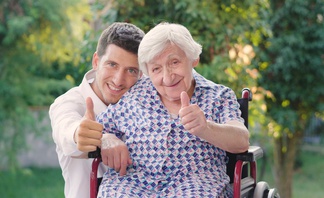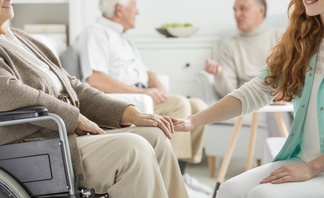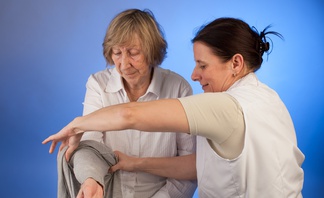Have you or someone you know fallen? You are not alone...more than one in every three adults over the age of 65 years, has a fall every year. Each year, 5 million older U.S. adults go to emergency departments for fall-related injuries.
One in five falls causes a serious injury such as broken bones or head injury. Among older adults, falls are the number one cause for losing independence, fracture and head injuries. Falls are the foremost reason for hospitalizations and deaths related to injury.
 The risk for falls increases with age and many older adults are afraid of falling. This fear becomes more common as people age, even among those who haven't fallen. It may lead older people to avoid walking, shopping, or taking part in social activities. But older adults who become less physically active are weaker and this increases their chances of falling. Many falls are preventable.
More than half of all falls occur in the home while people are doing their daily activities. Fall proofing the home could be as simple as removing tripping hazards such as area rugs (these have the tendency to bunch up and it’s best to remove them) and clutter. Electric cables should be secured to baseboards.
Toilet seats should be raised to above 16".
Oxygen lines are frequent culprits for falls, ask your doctor to order a portable oxygen compressor.

When tripping hazards cannot be removed such as: uneven or steep steps and walkways, (or pets), then increased awareness and installing grab bars and better lighting, can help.
Scared of taking a walk in the winter? The good news is that there are ways to protect against falls while staying active in winter. Experts in geriatric care offer the following tips:
Appropriate footwear during the winter months is essential. Rubber or neoprene soles, especially those with plenty of tread, provide better traction on snow and ice than either leather or plastic soles. Removable wire grips/cleats are great for walking on ice and snow. These cost around $30.

Planning ahead is essential. Think about the best route to your destination and add extra time to get there. Avoid rushing or taking shortcuts through the snow or over icy areas.
If you have to walk over slippery surfaces, bend your body slightly forward, take shorter strides, or shuffle your feet for better traction and stability.
Be careful getting into and out of the car. This is when many falls occurs. Take a quick look around to make sure your footing is clear when you step out of the car. Hold on to the car door as you make your first step out of the car.
Be aware of “black ice,” which is hard to see. Stay on clean, clear pathways or ones that have been treated with sand or salt.
Make sure you have a clear and level pathway to stand on, so you don’t lose your balance.
Take advantage of floor mats when you enter buildings. These help remove moisture from your shoes. Once indoors, avoid walking on wet or slippery surfaces. If you are at home, change out of your snow covered, wet shoes as soon as possible.
Frail seniors who are particularly at risk, should have a companion when walking outdoors.
Did you know?
Over 6 million adults use a walking device?
Over 70% of canes are faulty, damaged or the wrong height?
Only 20% people have been taught how to use their cane correctly?
All walking devices can contribute to falls if used incorrectly!
There are many walking devices available. The following is a quick comparison and review to guide you in the proper selection and use of one that best works for you or a loved one.
 Candy Cane
Candy Cane
Improves balance but should not be used for bearing weight. Umbrella handle can cause carpal tunnelsyndrome.
 Offset Cane
Offset Cane
For intermittent weight bearing.
 Quad Cane
Quad Cane
Can be used for weight bearing and can remain upright upon release. All four prongs must be plant.
A cane is used correctly when it supports the side opposite the weak or painful leg.
A candy cane or offset cane tilted backwards, indication of unsafe a excessive weight bearing and should be a warning that it’s time to change to a more stable device.

An easy way to assess the correct height of a cane is to match the top with the wrist crease when the arm is straight and hanging down.
Walkers provide more stability than canes however, they may be considered unattractive, and are more awkward and difficult to use with stairs.

Four-Wheeled Walker
Easiest to propel and maneuver. Usually have a built in brakes, seat and basket. Can be difficult to fold.

Front-Wheeled Walker
Maintains normal walking posture best.

Standard Walker
Greatest stability but requires lifting with each step. Slower and less natural gait.
Choosing the right walking device for you or a loved one and making sure that it’s fitted and used correctly may require consultation with your doctor or a physical therapist.
For people who live alone and have a history of falling, medical alert systems offer peace of mind that someone can be reached through a 24-hour monitoring service. There are many medical alert companies. All provide a waterproof neck pendant and wristband and usually a base station with wall mounted call buttons. Some offer a GPS mobile feature that works when you are away from home. Others, a mobile 911 phone, which places a call to local 911 services. Some offer motion-sensitive pendants that can detect a fall and place a call for help. Subscriptions usually cost $30-70 per month. Research should be done to find the best match for you or a loved one. A cheaper alternative may be just to always carry a cell phone.

CAN POPPING A PILL PREVENT FALLS?
The United States Preventive Services Task Force recommends taking a daily dose of 800 I.U of Vitamin D and 1-1.2g of Calcium. Studies have shown this can reduce the fall risk by 17 percent.
On the other hand, many medications have been associated with falls in the elderly. Taking four or more medications is a risk factor also. Almost any drug that acts on the brain or on blood pressure can lead to falls because of increased drowsiness, slowed reaction times, unsteadiness, or lowered blood pressure or heart rate. Those who are taking four or more medications, antidepressants, seizure medications, pain medications, muscle relaxants, sleep aids, blood pressure or heart medicines should ask their doctor to review their medications.
Medical conditions such as diabetes, heart and lung disease, and vision problems are common risk factors contributing to falls. Every fall should be regarded seriously and discussed with your doctor. A doctor or physical therapist may be the best person to help you..
I hope you found this article on fall prevention helpful. Please feel free to share copies with your friends and family. You can also send me questions and comments through my website at www.wendys-team.com. If you’d like me to talk about any other healthcare related topics in a fireside chat, just let me know!
Dr Wendy





